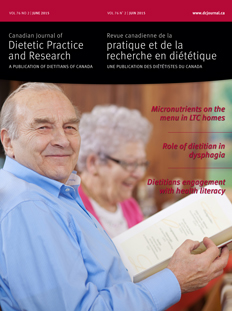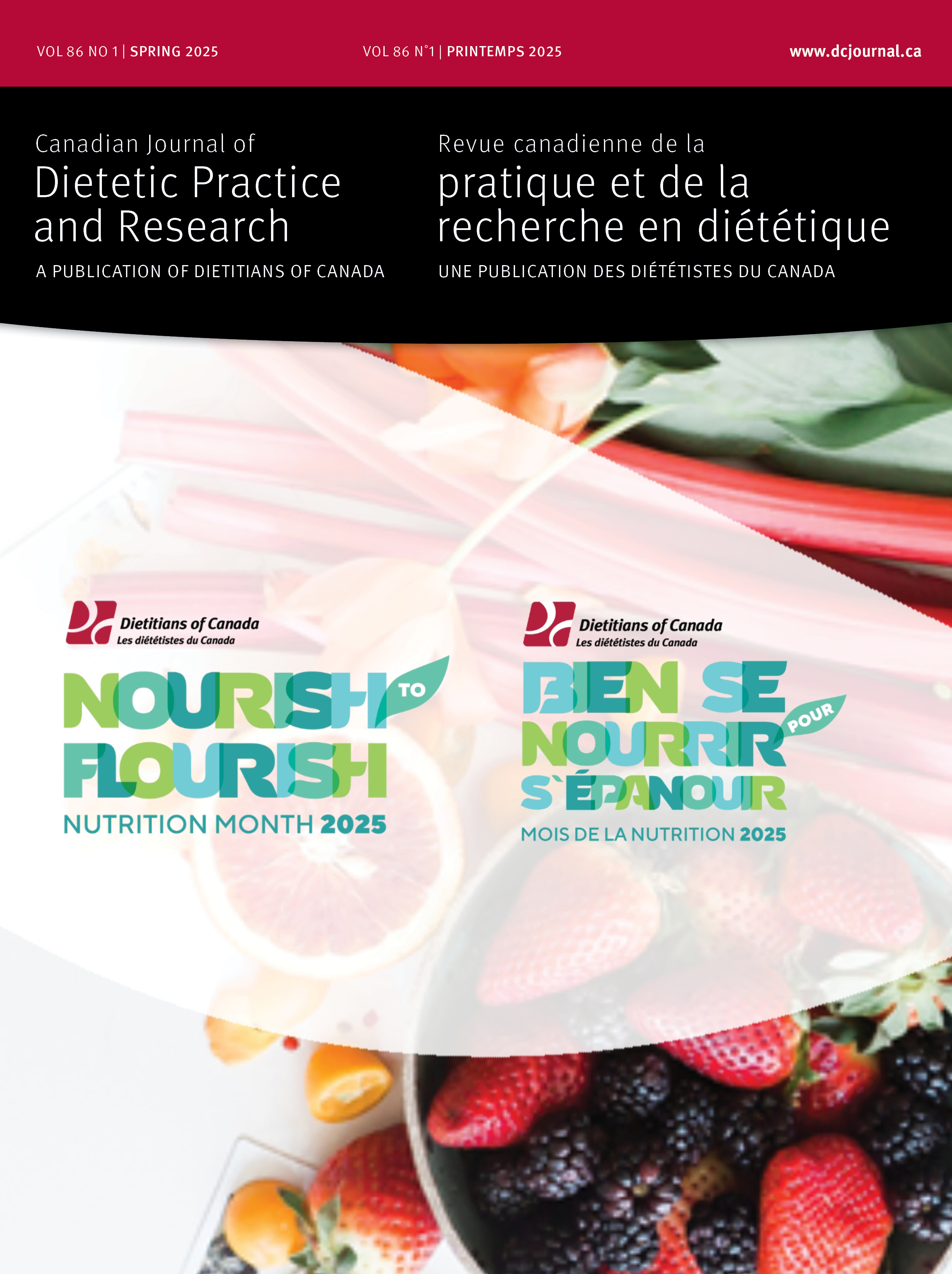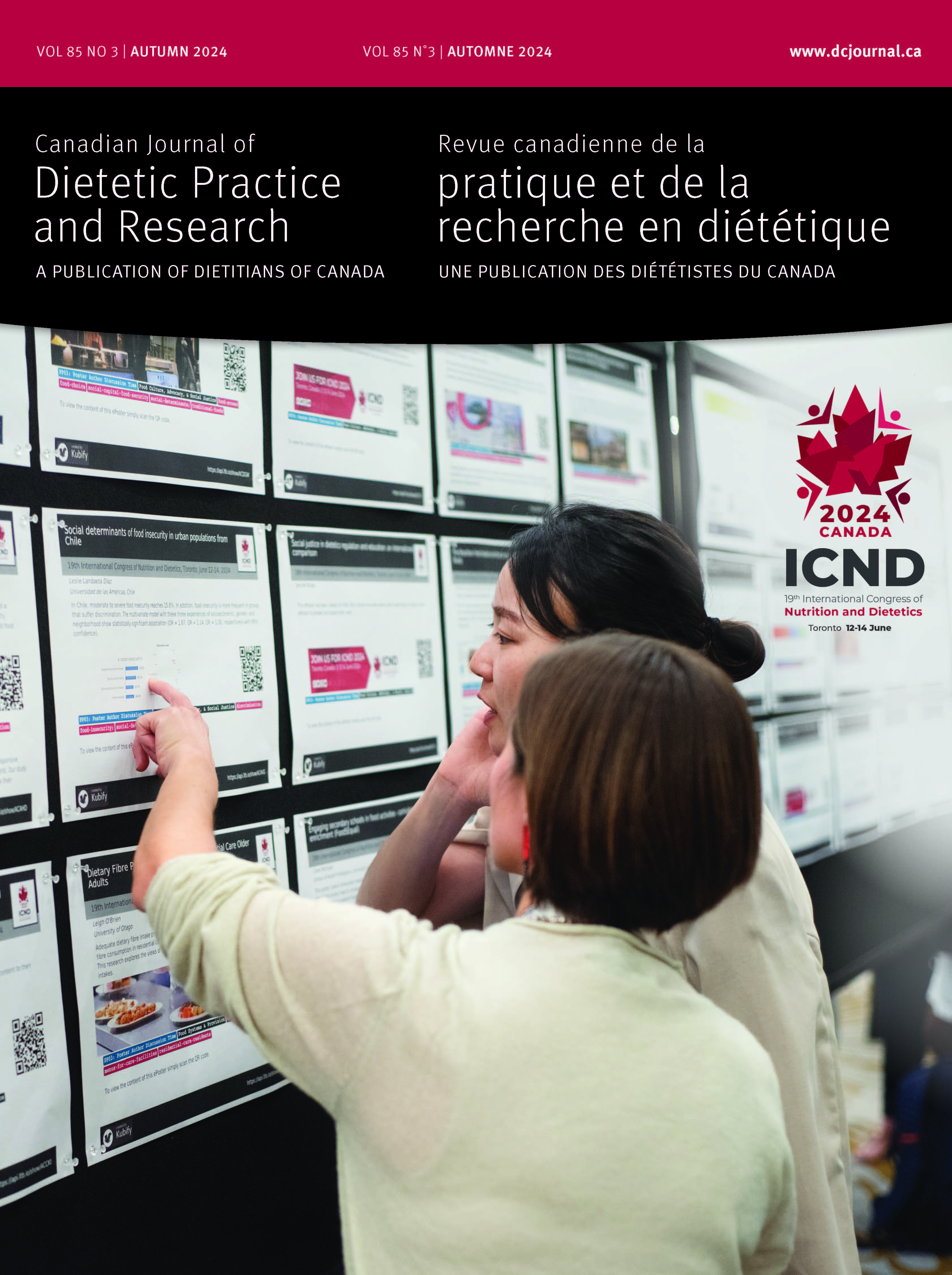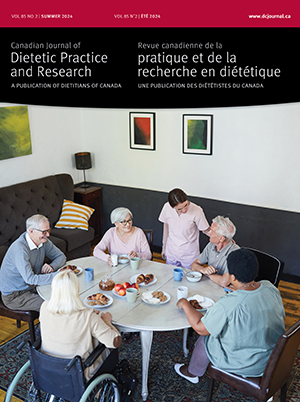Volume 76 • Number 2 • June 2015
Chair's Message
Editor's Message
Original Research
Purpose: Recognition of health literacy as a serious problem in Canada calls for all health practitioners to rethink how they provide health information. This qualitative research study explored how Canadian dietitians understand the multifaceted concept of health literacy and, if and how, they apply it in their practice. Methods: Nine dietetic or nutrition practitioners from different practice settings were purposely selected through an environmental scan of health literacy interventions, professional networks, and interviewee snowballing. Qualitative data were collected using conversational-style personal interviews and thematically analyzed through an iterative process of constant comparison. Results: All participants recognized value in addressing health literacy in their practice with many barriers and enablers to its application identified. Participants referred to difficulties in communicating nutrition information to people with low levels of functional literacy, reflective of a deficit approach to health literacy. However, practices consistent with the more empowering concepts of interactive and critical health literacy, reflective of an asset-based approach, were also described. Conclusion: This research provides a preliminary picture of how dietitians engage with health literacy in various settings in Canada and suggests implications for developing strengths-based health literacy approaches to dietetic practice.
Purpose: Little is known regarding nutritional adequacy of the gluten free diet (GFD) in children and adolescents with celiac disease (CD). The study aim was to examine macro- and micronutrient intake in children with CD. Methods: A cross-sectional study was conducted in children and adolescents (4–18 years of age) with CD (n = 32) and healthy controls (n = 32). Macro- and micronutrient intake, and glycemic index (GI) and glycemic load (GL) intake was assessed using validated measures. Diet quality was assessed using the Canadian Healthy Eating Index (HEI-C) and the Alberta Nutrition Guidelines. Values are shown as mean ± SE. Results: Age (10.4 ± 0.7years vs 8.7 ± 0.7 years; P = 0.06), weight-for-age z score (P = 0.27), and height-for-age z score (P = 0.23) were not different between groups. CD children consumed more fibre (15.9 ± 1.2 g per day(CD) vs 10.8 ± 0.8 g per day (controls); P < 0.001), had higher GI (CD: 54 ± 2 vs 48 ± 1; P < 0.01) and GL (CD: 118 ± 8 vs 93 ± 7; P = 0.02), and lower folate (146.7 ± 15.3 (CD) vs 245.4 ± 21.8 µg per day (controls); P < 0.001) than controls. No differences in HEI-C scores (≤ and > 80) were observed between groups (P > 0.05). Conclusion: Children with CD had high intakes of fibre, GI, and GL and lower intakes of folate. This has implications for dietary counselling in this population.
Purpose: The purpose of this study was to explore the concept of scope of practice in dietetics in Canada. Methods: Using interpretative description methodology, data were collected through 4 phases. This article reports on phases I and IV. In phase I, 8 provincial dietetic regulatory bodies participated in semi-structured telephone interviews on dietetic scope of practice. Phase IV consisted of a document analysis of Canadian dietetic scope of practice statements. Results: A review of dietetic statements found in legislation across Canada has shown considerable variability in terms of length, wording, and reference to specific practice areas. Phase I participant discussion focused on 3 concepts: creating a scope of practice, using a scope of practice, and perceived or expected outcomes of a scope of practice. Conclusion: Dietetic scopes of practice statements are a product of a complex multi-player process. The nature of provincial health care makes it unrealistic to expect similar dietetic scope of practice statements across all provinces. However, maintaining relationships between dietetic regulatory bodies can aid in the replication of ideas, best practices, and policies between provinces.
Objectifs. Décrire les motivations, les objectifs d’études et de carrière, et la satisfaction des futurs professionnels de la nutrition au Québec. Méthode. Un questionnaire électronique a été envoyé aux 158 finissants en nutrition des trois universités du Québec offrant un programme de nutrition. Les données ont été analysées avec le logiciel SPSS. Des statistiques descriptives ainsi que des tests du χ2 et de McNemar ont été utilisés. Résultats. Au total, 72 étudiants ont rempli le sondage. La nutrition était le premier choix de programme pour 60 % d'entre eux. Un intérêt pour la nutrition, la santé et les aliments, et le désir d'aider autrui étaient les principales motivations pour entreprendre des études en nutrition. La nutrition clinique est le secteur d'activités privilégié par les étudiants pour l'obtention d'un emploi, suivie de la nutrition publique et de la pratique privée. Cinquante-cinq pour cent des étudiants prévoient faire des études supérieures en nutrition et 28 %, dans un domaine connexe. Le programme d’études en nutrition a répondu aux attentes de 70 % des étudiants. Conclusion. Les résultats démontrent la nécessité d'une formation pratique permettant de répondre aux besoins de milieux diversifiés, notamment celui de la nutrition publique, qui est un domaine prometteur. Par ailleurs, plus d'information sur le contexte de travail devrait être intégrée au programme d’études.
Perspectives in Practice
The aim of this cross-sectional study was to survey exercise specialists about nutrition counselling practices, their own dietary practices, and to identify potential relationships. An electronic survey was used to examine characteristics and strategies used for assessing and promoting healthy eating to clients. Exercise specialists (n = 94) were recruited through a public registry and through targeted advertising on 2 professional websites in Alberta, Canada. Eighty-five percent of respondents promoted healthy eating to clients. Confidence in assessing and promoting healthy eating was moderate to low. Those with more than 6 years of professional experience reported higher confidence compared with those with less than 1 year of experience in assessing healthy eating (P < 0.05) and promoting healthy eating (P < 0.01). Confidence was higher among those with more professional experience but who did not meet Canada's Food Guide recommendations (P < 0.05). Professional experience, personal dietary practices, and confidence are important characteristics when considering the assessment and promotion of healthy eating by exercise specialists. Promoting collaborative relationships between registered dietitians and exercise specialists would likely benefit exercise specialists when they are assessing and promoting healthy eating among their clients.
The study evaluated the impact of a pilot “protected mealtime” program on meal experience and care of hospitalized acute care patients. A 4-month pilot protected mealtime program was implemented on a 35-bed acute, older adult ward. A pre- and post-observational audit was implemented to examine interruptions during lunch, food intake, hand hygiene, and positioning practices on the ward. A staff questionnaire was administered to gain the opinions of health care team members about the protected mealtime program. The observational audit showed a significant decrease in the number of total interruptions (Z = −2.496, P = 0.013, r = −0.42). Hand hygiene practices improved and no effect was found on mealtime patient positioning at mealtimes. Staff questionnaire responses indicated positive changes to the patients’ mealtime experiences. The protected mealtime program appeared to improve patient mealtime experiences and patient care. Enabling patients to eat their meals uninterrupted will assist in ensuring that patients in hospital are adequately nourished.
Micronutrient (vitamin and mineral) deficiencies may exacerbate prevalent health conditions occurring in long-term care (LTC) residents, and current food provision may potentiate this problem. A micronutrient-focused, food-first approach to menu planning may address this gap by emphasizing nutrient-dense foods. The objectives were to determine if: (i) selected LTC menus met micronutrient and Canada's Food Guide (CFG) recommendations, and (ii) recommendations can be met through food alone with strategic menu planning. Regular, nontherapeutic menus (week 1, all meals) from diverse LTC homes (n = 5) across Canada were analyzed for micronutrient content using Food Processor and CFG servings. Site dietitians confirmed menu analyses. Five super-menus were created and analyzed for comparison. The nutrient content of the menus varied significantly across homes. Micronutrients of greatest concern were (mean ± SD) vitamin D (8.90 ± 5.29 µg/d) and vitamin E (5.13 ± 1.74 mg/d). Folate, magnesium, and potassium were also below recommendations. Super-menus of equal food volume met recommendations for all micronutrients except vitamin D (56%), vitamin E (84%), and potassium (85%). Meeting most micronutrient recommendations is possible with creative and deliberate menu planning. Knowledge translation of best practices is needed.
Report
Purpose: This study describes dietary changes among university students who completed a travel study program. Methods: Seventeen undergraduate nutrition students travelled from Edmonton to Italy for 6 weeks to take 2 courses on the Mediterranean diet. In both locations students completed a 24-h dietary recall and a Food Frequency Questionnaire to assess their Mediterranean Diet Quality Index Score (MDQIS). A MDQIS of 48 indicates perfect adherence to eating patterns of the Traditional Healthy Mediterranean Diet Pyramid (THMDP). Results: While in Italy students altered their diets in positive ways (increased consumption of fish and seafood (P = 0.002), wine (P < 0.0001), and olive oil (P = 0.001)) and negative ways (increased consumption of sweets (P = 0.027), poultry (P = 0.001), and meat (P = 0.049)) relative to the THMDP. Students had a significant increase in the percentage of energy from polyunsaturated and monounsaturated fatty acids and alcohol. The MDQIS was low in Edmonton (21.9 ± 3.7) and Italy (22.9 ± 3.9). Conclusions: The overall dietary pattern of students did not adhere to the THMDP. Education about the THMDP and living in Italy for 6 weeks was insufficient to change students’ dietary patterns to one characterized as traditional Mediterranean. The findings highlight the challenges of implementing dietary changes even with nutrition education and increased food access.
Purpose: To assess the status of food and nutrition programming in community-based HIV organizations in Canada. Methods: A telephone survey was administered to 80 community-based HIV organizations asking about characteristics of food and nutrition programs and the perceived program gaps. Results: The majority of organizations had programs directed at improving food access through meals, food banks, community kitchens or cooking classes, food vouchers, gardens, and street vans. Almost half of the organizations (n = 39) provided nutrition counselling by a registered dietitian or nurse, and the majority also provided referrals to other food and nutrition services in the community. Most organizations would like to have more food-related programming, including: more frequent provision of nutritious and fresh food options, methods to make better use of available food, transportation and grocery vouchers, more staff dedicated to food programs, and improved food preparation and storage infrastructure. Conclusion: Although community-based HIV organizations provide a range of food and nutrition programs, they face challenges due to inadequate resources. Decision makers should provide more funding for these programs; however, they must be augmented with other supports such as adequate housing, income, and addiction counselling. Dietitians can help organizations maximize the impact of their limited resources and can advocate for systemic changes to enhance determinants of health for people living with HIV.










